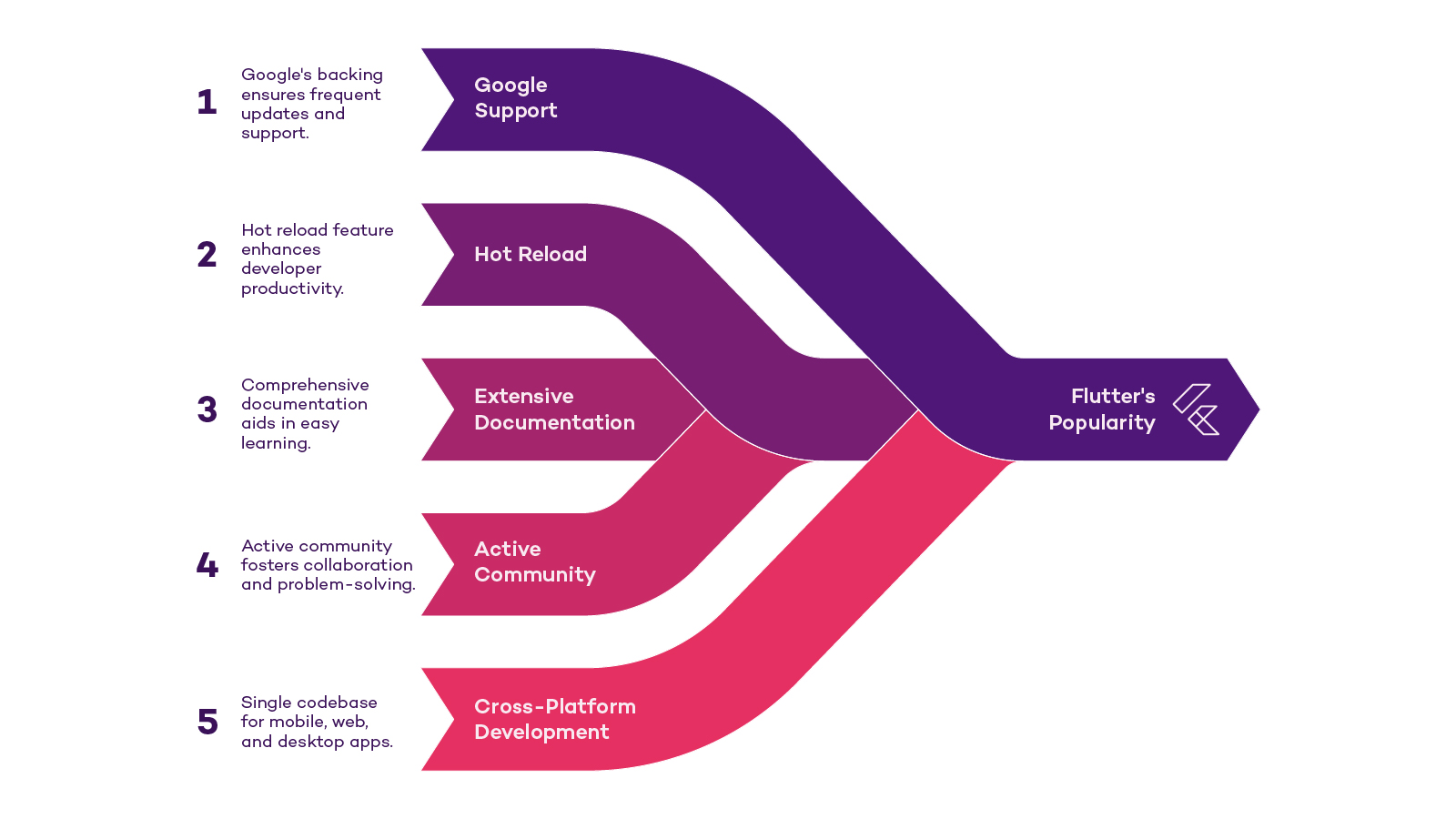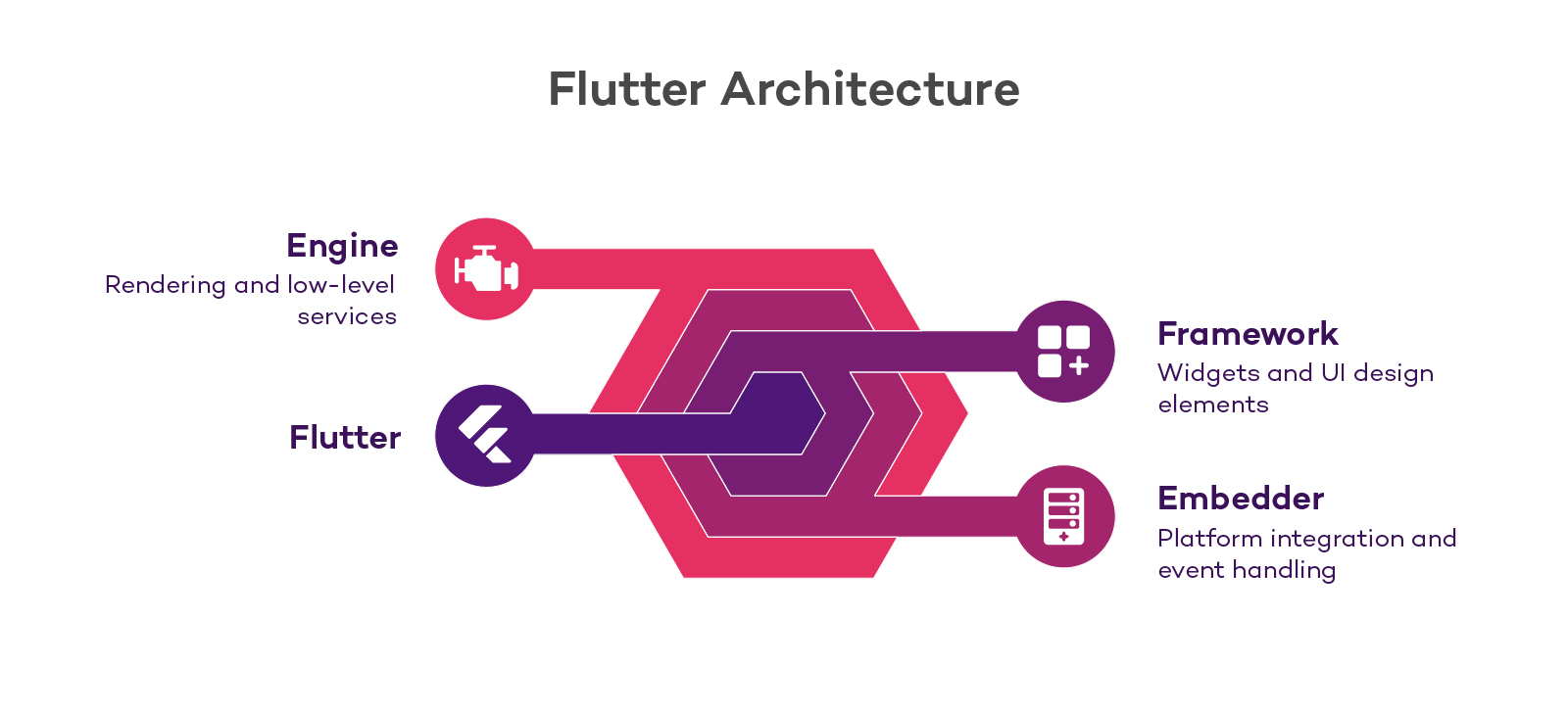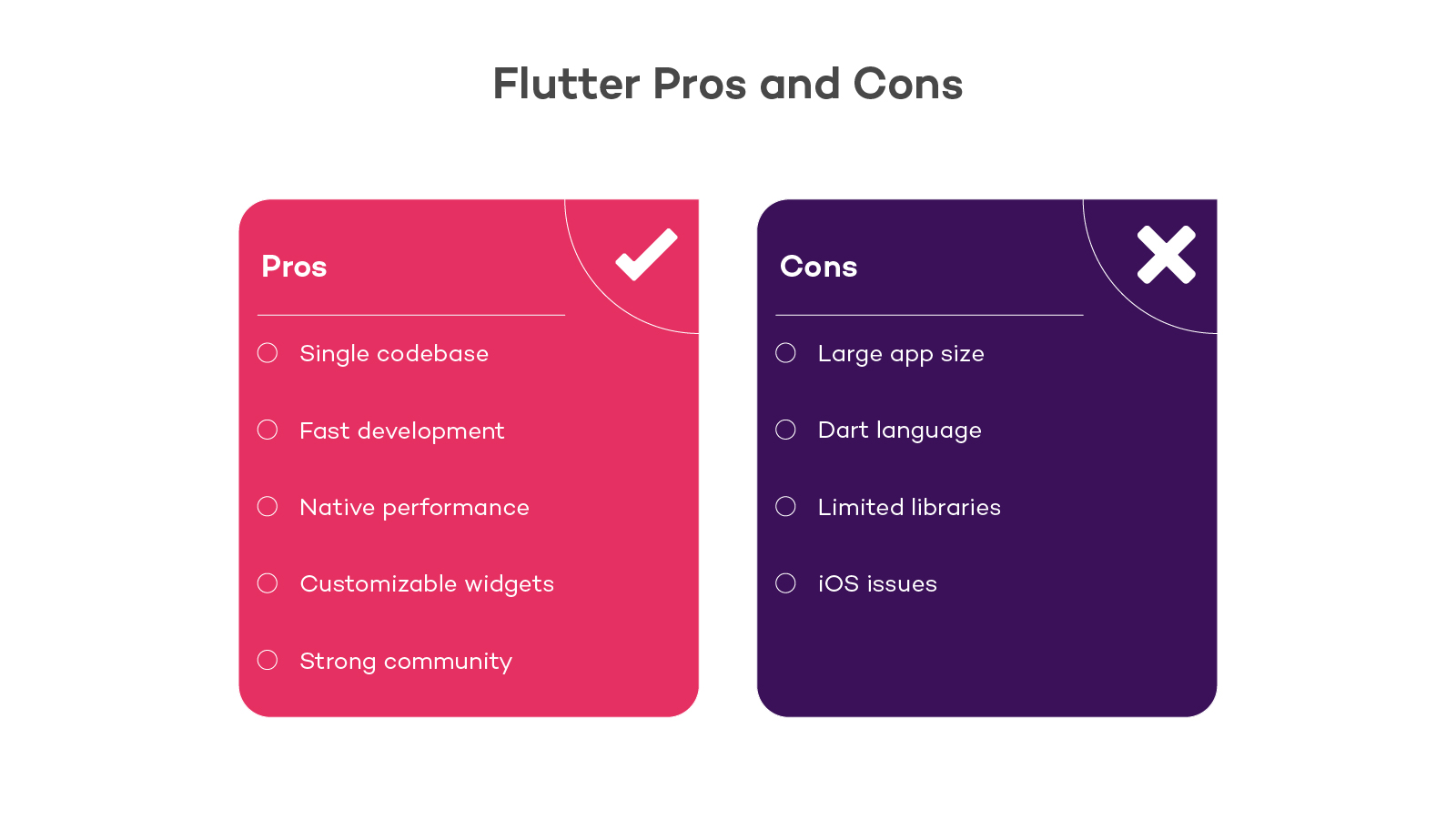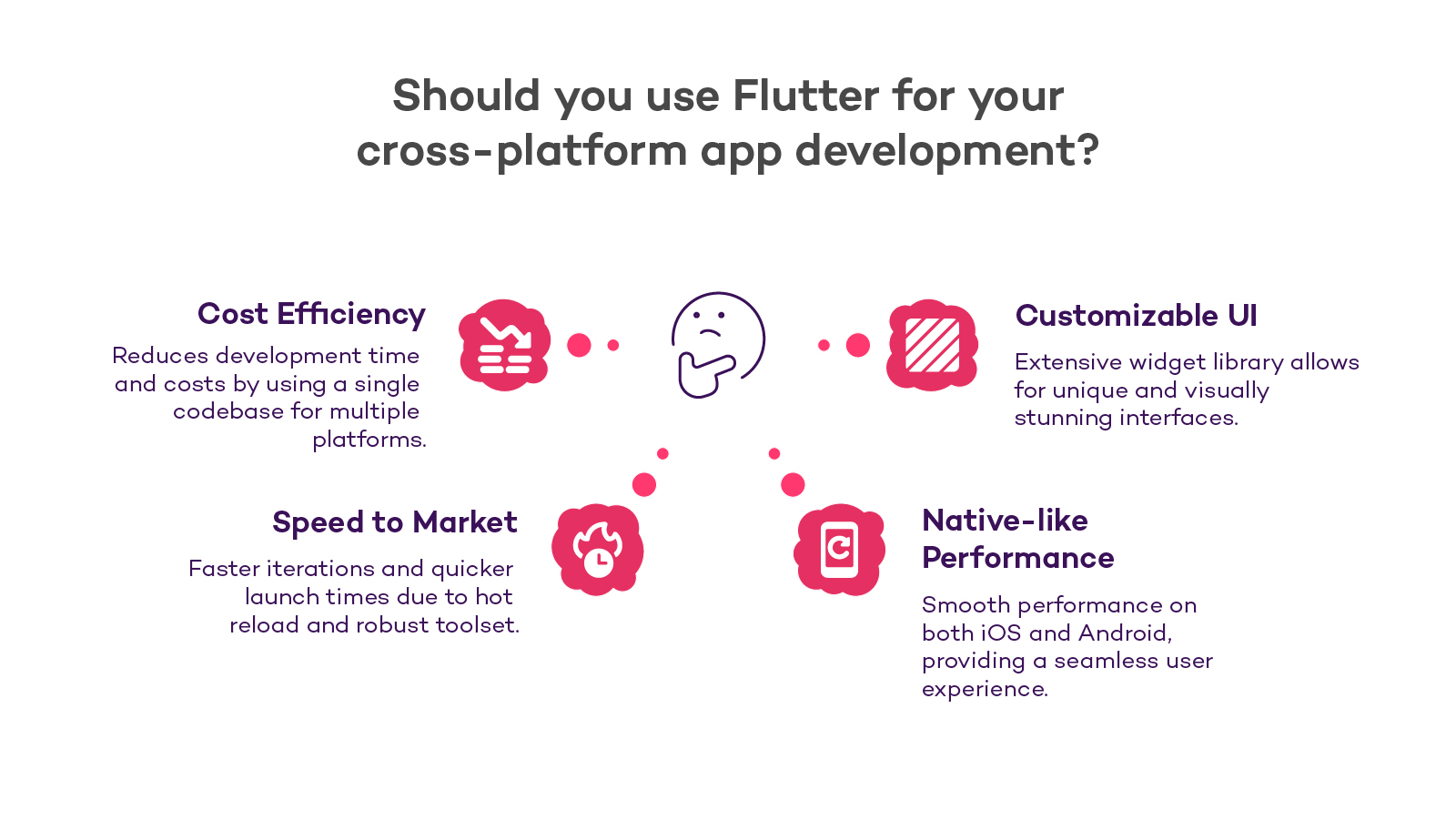While there are plenty of different alternatives when it comes to open-source frameworks and their use for app development these days, there aren’t many of those that are as effective and reliable as Flutter. As a client looking to build an app that is potentially a game-changer you need two things:
- A top-tier tool that will make the whole process straightforward.
- A team of professionals that will use that same tool to bring any idea to life (hint: that’s where Tapptitude comes into play).
Today, we’ll focus on one of the most popular alternatives – Flutter app development. Regardless of whether you’re already familiar with it or are just browsing all the best possible options, this guide should be a good starting point.
Now, before we get into the in-depth overview of the pros and cons of Flutter, let’s try to understand what this framework actually is.
What exactly is Flutter?
As only briefly mentioned above, Flutter is an open-source UI framework. It was developed by none other than Google back in May 2017 and has been a staple in the industry ever since. Flutter has gained popularity due to its ability to deliver native performance and visually pleasing user interfaces, among other features.
What makes it quite convenient is the fact that it allows developers to create high-quality mobile, web, and desktop applications from a single codebase. Of course, Flutter is not unique in that sense, as many other frameworks allow its users to do so, but there are other perks that make this Google-made framework stand out.
Compared to its competitors, Flutter does not rely on web technologies or bridge mechanisms but rather uses its own rendering engine. By doing so, apps built using Flutter perform exceptionally well on both iOS and Android.
So, how did Flutter become so popular?
Ever since its release roughly a decade ago, Flutter has seen rapid adoption across the development community. Some of the factors that can be attributed to its rise in popularity are:
- As a Google product, Flutter benefits from both frequent updates and extensive support.
- Some of the features that we will pay more attention to later in the article like hot reload, extensive documentation, and an active community are quite appealing to developers – especially to those who are looking to focus on a single framework.
- Since Flutter is able to target multiple platforms from a single codebase, it is a cost-effective solution for businesses – big and small.
Some other top choices alongside Flutter here would be React Native and Xamarin.

Flutter use cases and examples
It’s precisely Flutter’s versatility that makes it suitable for a wide range of applications. Here are some examples:
- Google Ads – Probably the most “basic” and straightforward example. Google Ads app allows users to manage their Google Ads campaigns directly from their mobile devices. This means that the user can get real-time updates and notifications.
- eBay Motors – As you can probably guess from the app name, eBay Motors is a specialized app for buying and selling cars. eBay opted for Flutter here as the final product offers a seamless and engaging user experience.
- BMW App – An app used by BMW drivers to locate parking spaces, share locations, and find points of interest. This is a solid example in Flutter’s portfolio as it showcases its ability to handle complex, real-time data.
Some other notable companies that use Flutter’s services are, among others: Xiaomi, SNCF Connect, Wolt, Whirlpool, Universal Studios, Supercell, Monta, Etermax, Virgin Money, Tencent, and more.
If you’d like your own brand to be a part of this club, Flutter is probably the way to go.
Key components of Flutter
The three key components that we think are quite worth pointing out are:
- Framework – The Flutter framework is built using the Dart programming language. It includes a comprehensive set of pre-designed widgets. These widgets make it easy to create complex UIs that follow platform-specific design guidelines.
- Embedder – The embedder is platform-specific and integrates the Flutter app with the operating system. This component handles not only input and output but also the event loop. This ultimately ensures that the app runs smoothly on any platform.
- Engine – The engine is written in C/C++ and uses Google’s Skia graphics library. It handles rendering, manages the Dart runtime, and provides low-level services such as accessibility support and text layout.

All the pros – Flutter as one of the best cross-platform options out there
Now that we understand Flutter as a framework slightly better, let’s take a look at the focus of this guide – Flutter pros and cons:
- Single codebase for multiple platforms – In our opinion, the biggest benefit of Flutter app development.
- Faster development cycle – A feature like hot reload is quite useful when it comes to speeding up the development process. While not a Flutter-specific feature, hot reload allows developers to see the effects of code changes almost instantly without restarting the entire app. This means that when you modify the code, the changes are reflected in the app's UI immediately.
- Native-like performance – Thanks to the Skia graphics engine, Flutter apps perform nearly as well as native apps – something that not many similar frameworks can boast.
- Customizable widgets – Flutter’s huge library of widgets makes it easy to create complex and aesthetically pleasing UIs at the same time. These UIs adhere to platform-specific design guidelines.
- Strong community support – Having an active community means strong support. By using Flutter, you’re going to be a part of a group that uses this framework on a daily basis. This community offers everything you’ll need when creating your app – resources, tutorials, and support. Maybe even a Reddit post with a specific issue that you need help with and that someone had a couple of years ago.
- Google’s backing – Continuous updates and enhancements from Google ensure Flutter stays competitive and reliable.

What challenges does Flutter bring?
One thing is for certain: a perfect tool does not exist. Many developers would agree on the fact Flutter is a somewhat optimal option, however, due to it having more advantages than disadvantages. That being said, some of the downsides of using Flutter are:
- Large app size – Flutter apps tend to be larger than those built with some other frameworks, which can be a drawback for users with limited storage. While the solution for this problem might be simple, like buying an external SSD, keep in mind that some developers work in limiting environments.
- Dart Language – With Dart being the focal point of learning Flutter, it’s still less popular than JavaScript. This might limit the pool of developers familiar with it and put off those who are not as enthusiastic as let’s say, some junior developers when it comes to learning a new framework.
- Limited Third-Party Libraries – Although growing, the ecosystem of third-party libraries for Flutter is still smaller compared to more established frameworks. We did mention that Flutter has strong community support where people share resources, but some developers might find the lack of some third-party libraries off-putting.
- iOS Compatibility Issues – Being developed by Google, Flutter’s iOS performance and integration might not always match that of Android. This is a good example of a scenario where it’s better to use a native framework. If, on the other hand, you’d like to focus on a specific platform rather than work in a cross-platform framework, Flutter might not be the best option out there.
Starting your Flutter app development journey
So, you finally decided that your next project should involve a cross-platform framework. Choosing the right alternative can be somewhat overwhelming, especially with the plethora of tools and frameworks available today.
However, if you're looking for a solution that combines efficiency, flexibility, and cost-effectiveness, Flutter stands out as an excellent choice. To summarize the pros and cons of Flutter, here are the key points you should keep in mind when starting your Flutter journey.
- Cost efficiency – As a client, sometimes you have to work on a tight budget. Using only a single codebase for multiple platforms, Flutter drastically reduces development time and costs.
- Speed to market – We already mentioned Flutter's hot reload feature and its robust toolset, but how does that affect someone who is not a developer but rather a client? Well, those features allow for faster iterations and quicker launch times. This again makes Flutter a cost-effective framework.
- Native-like performance – While Flutter is not a native development option, the final product it provides will perform smoothly on both iOS and Android. This will ultimately offer users on either platform a seamless experience.
- Visually pleasing, customizable UI – Flutter’s extensive widget library ensures your app can have a unique, visually stunning interface that aligns with your brand – A more recognizable brand means more reach, and ultimately more income.

FAQs
Will Flutter replace React Native and Xamarin?
This is one of those questions that you can’t quite answer with a simple yes or no. While Flutter has the potential to replace other frameworks due to its ease of use and performance, it’s hard to say if it could completely replace React Native and Xamarin. Each framework has its own strengths and ideal use cases, and some developers tend to adapt to certain environments better than to other ones.
Is Flutter suitable for startups?
Of course! Flutter is an excellent choice for startups as it allows rapid development and deployment across multiple platforms. By using a single codebase, Flutter saves both time and money.
Is Flutter good for enterprise application development?
Absolutely! As much as it is useful for smaller companies and startups, many large enterprises are adopting Flutter for its ability to create high-performance, scalable apps. As we already mentioned, Google, BMW, and eBay all use Flutter to create their mobile, web, and desktop apps.
Is it possible to add Flutter to an existing app?
Yes, you can easily integrate Flutter into an existing app incrementally using Flutter modules – This applies to both iOS and Android.
How Tapptitude can help you build your next mobile app
At Tapptitude, we specialize in transforming ideas into successful projects. Flutter is only one of the tools we use to deliver innovative and impactful apps. Here’s what we’ve built with Flutter so far.
Some examples of us working with Flutter
Even before writing this guide, we had our own small list of Flutter pros and cons. That same list helped us see the potential that Flutter offers. Ultimately, we’ve created a plethora of apps for various clients. Some of those that we’re most proud of are:
Reverse Health
Reverse Health offers a targeted solution for women struggling with menopause-related weight gain. Our app provides a comprehensive program to help women lose weight, improve sleep, and manage hot flashes, ultimately enhancing overall quality of life.
Crowdrock
Help others with your opinion and earn money with it.
Your opinions shape the world around you. Every day, consciously or not, you share thoughts and preferences that influence businesses and trends. But have you ever considered turning those opinions into real value?
These two examples are something we feel quite proud of. The reason is simple. Tapptitude is not only a mobile app development company, but also a team that tries its best to make everyone’s daily life a bit more convenient.
Why work with us?
Choosing the right development partner is just as important as choosing the right technology. Here’s why Tapptitude could be the ideal choice for your Flutter app development needs:
- Proven expertise
- Client-centric approach
- Tailored solutions
- Transparent communication
If you’re ready to take your business to the next level with a high-quality mobile app, we’re here to help. Partner with us to leverage the full potential of Flutter and create an app that stands out.
Contact us today to discuss Flutter pros and cons and your project – Let’s find out how we can turn your vision into reality!
Ready to launch your next project?
Let's chat!Tapptitude
Tapptitude is a mobile app development company specialized in providing high-quality mobile app development services, and a top-rated app company on Clutch.














